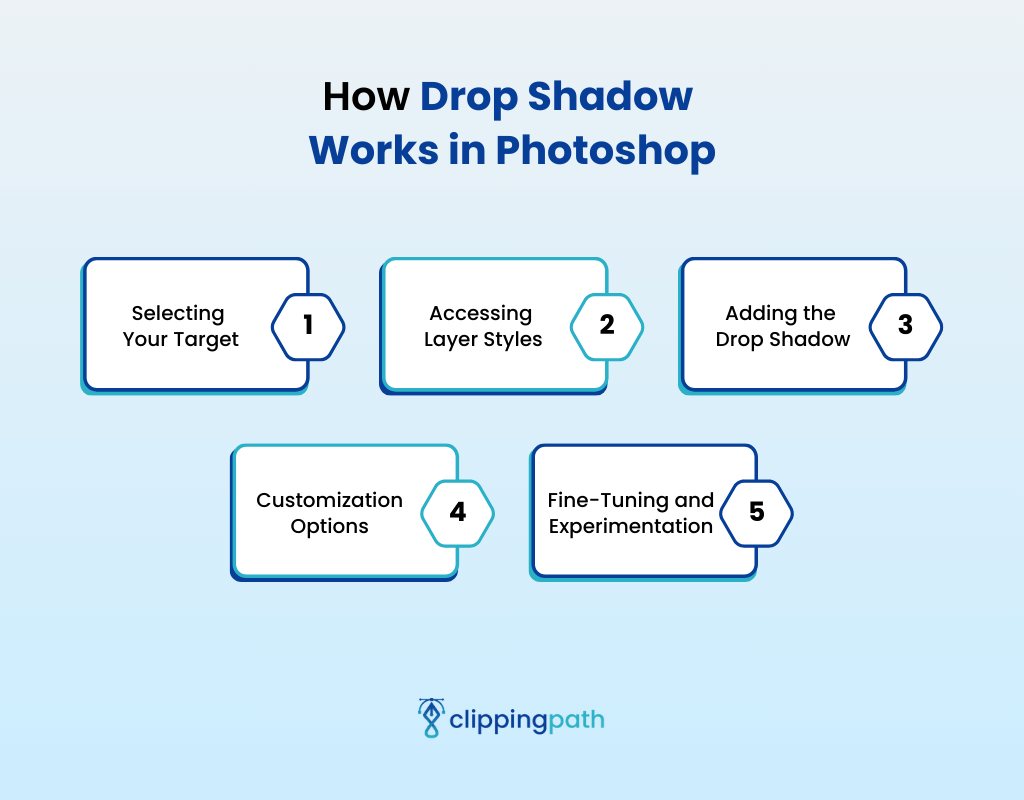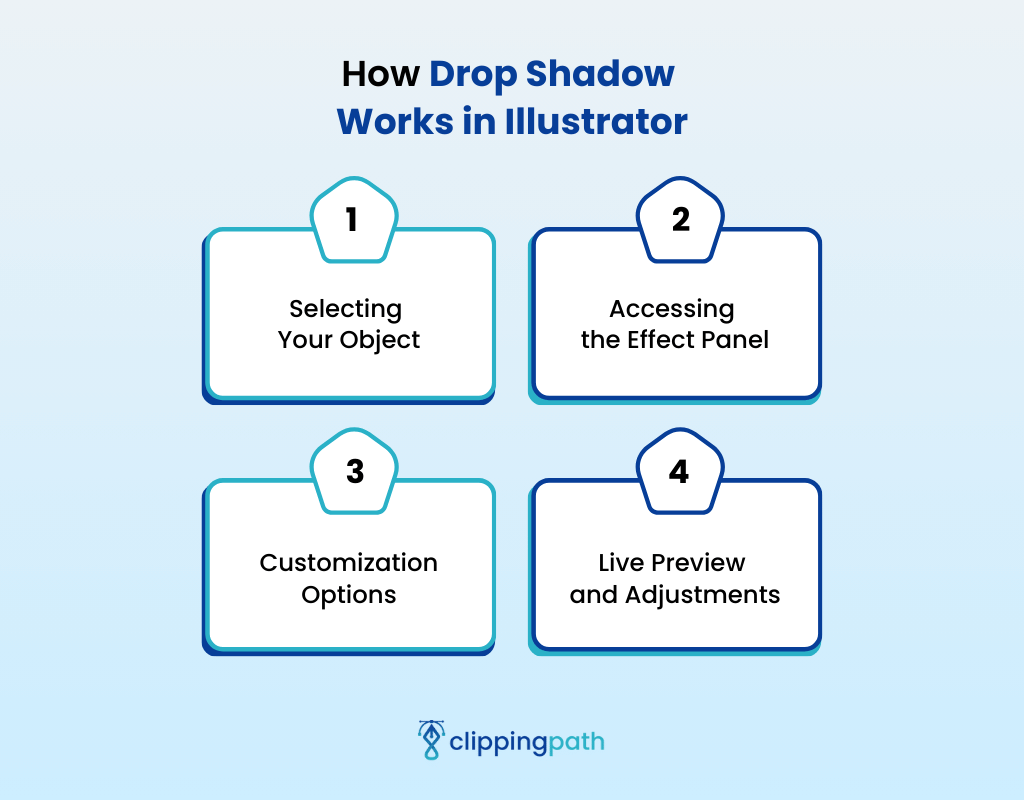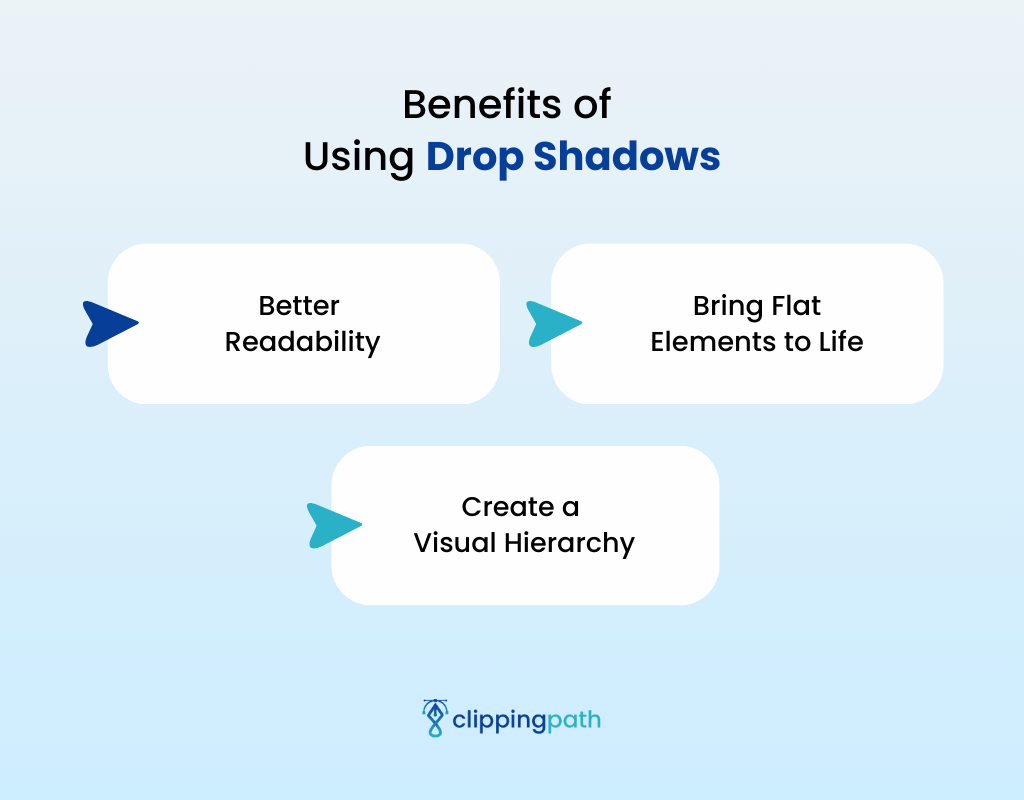Have you ever noticed how a single object can appear flat and lifeless in a photograph or illustration? It might be missing a key ingredient – a drop shadow. But what is the drop shadow?
A drop shadow is the effect of light hitting an object. It creates a darkened area beneath it. This effect adds a sense of depth and dimension. You can make the object look like it’s lifting off the background! Now, you can add drop shadows and customize in both Photoshop and Illustrator.
However, there are many drop shadow settings and advanced techniques to transform your images. Keep reading to unlock the secrets of drop shadow effects for photo editing!
What is a Drop Shadow?
A drop shadow is a design technique that creates the illusion of a shadow cast by an object. This simple yet powerful effect adds a sense of depth and dimension. You can use a drop shadow to make flat elements look more realistic and visually separate from the background!
Types of Drop Shadows You Can Find in Photoshop and Illustrator
The type of drop shadow you choose will depend on what your design is and which effect you want. Even though the core concept remains the same, you can customize drop shadows for various stylistic effects:

Classic Drop Shadow
This is the most common type that creates a realistic shadow with a slightly blurred edge. It usually appears directly below and slightly behind the object.
Inner Shadow
This effect creates a shadow that appears to be coming out from within the object itself. It’s often used to add depth and detail to buttons or 3D shapes.
Long Drop Shadow
As the name suggests, this type creates a long shadow that goes further away from the object. You can often use this technique to create a dramatic or stylized effect. It works best for text or logos!
Colored Drop Shadow
Instead of the standard black or gray, you can use a colored drop shadow. This can add a pop of color and vibrancy to the design. If you want a playful or cartoonish style, go for it!
Harsh Drop Shadow
If you want to create a harsh drop shadow with sharp edges, reduce the blur. This is often used to mimic a strong light source. Get a modern and minimalist look!
How Drop Shadow Works in Photoshop
Photoshop is a raster-based image editing software. It offers a diverse set of options for creating and customizing drop shadows. You can easily add a drop shadow in Photoshop!
Here’s a brief overview of the steps you need to follow –

- Selecting Your Target
Firstly, you have to choose the element you want to apply the drop shadow to. You can pick a text layer, an image layer, or even a shape.
- Accessing Layer Styles
Go to the “Layer” panel and find the desired layer. At the bottom of the panel, you’ll find a small “fx” icon. Now, click on this icon to access the “Layer Styles” menu.
- Adding the Drop Shadow
Within the “Layer Styles” menu, select “Drop Shadow.” This opens a dedicated dialogue box with various controls for customizing your shadow. You can easily add a drop shadow to images or texts!
- Customization Options
The drop shadow dialogue box offers many options to fine-tune the effect. Here are some key settings:
- Blend Mode: This determines how the shadow interacts with the background color. “Multiply” is a popular choice for realistic shadows.
- Opacity: You can control the darkness of the shadow by changing the opacity level.
- Angle: This defines the direction of the light source. You can use it to influence the shadow’s direction.
- Distance: If you want to set how far the shadow should be offset from the object, use the distance option.
- Spread: Depending on the object, you may need to control the edges. You can use the spread option to adjust the softness or harshness of the shadow.
- Size: Want to increase or decrease the length and width? The size option can change the overall size and blurriness of the shadow.
- Fine-Tuning and Experimentation
The beauty of Photoshop’s drop shadows lies in their flexibility. Don’t be afraid to experiment with different settings to achieve the desired effect!
Pro Tip: Use the “Preview” checkbox in the drop shadow dialogue box. Here you can see the changes reflected in real-time as you adjust the settings.
How Drop Shadow Works in Illustrator
While Photoshop deals with pixels, Illustrator is a vector graphics editor. This means objects in Illustrator are created using mathematical paths.
This makes them infinitely scalable without losing quality. Illustrator’s drop shadow functionality differs slightly from Photoshop’s.
Here’s how drop shadows generally work in Illustrator –

- Selecting Your Object
Choose the vector shape or text element to which you want to apply the drop shadow.
- Accessing the Effect Panel
Go to the top menu bar and select “Effect”. Then find the “Blur” option and finally “Drop Shadow.” Alternatively, you can use the keyboard shortcut (Shift + Ctrl + Alt + B).
- Customization Options
Similar to Photoshop, Illustrator offers various controls for customizing the drop shadow. You can find many drop shadow settings!
- Blur: You can use this to adjust the softness of the shadow’s edges.
- Offset: This option helps you to set the distance of the shadow from the object.
- Opacity: Want to make the shadow lighter or darker? Use the opacity option to control!
- Color: The color setting lets you choose a color for the shadow. You don’t always have to stick to the standard black or gray.
- Angle: After you set the direction of the light source, the angle option helps you adjust the shadow.
- Live Preview and Adjustments
Illustrator offers a live preview of the drop shadow as you adjust the settings in the panel. This allows for quick and precise control.
Benefits of Using Drop Shadows
You can elevate your designs to new heights with some drop shadow settings. Here’s why you should try drop shadows –

Better Readability
A subtle drop shadow behind the text acts like a gentle halo. This separates it from the background, especially on busy designs. Now you can make your message crystal clear, reducing eye strain for viewers!
Bring Flat Elements to Life
Ever feel like your graphics lack some depth? Drop shadows add a touch of magic! You can now transform your flat illustrations into grounded and realistic elements. This instantly improves the visual appeal of your design.
Create a Visual Hierarchy
Drop shadows act like organizers in a design. They can establish a clear hierarchy by creating visual separation between objects and the background. Now viewers’ eyes are naturally guided through your design. They can easily understand what’s most important at first glance!
Final Words
Need your graphics to feel more real? A touch of drop shadow adds depth. You can now easily add a drop shadow in both Photoshop and Illustrator!
To sum up the drop shadow definition, it’s a simple technique with a big impact. Drop shadows can take your designs from flat to fantastic! They add depth, dimension, readability, and realism.
Don’t be afraid to experiment with different drop shadow settings to get the best result.

Meta Clipping Path – A well-known one-stop photo editing service provider company with 5+ years of experience and 25+ highly skilled professionals.
Working with 20 reputed worldwide e-commerce companies and 200+ satisfied customers.
![You are currently viewing Drop Shadow Definition and How It Works [Everything You Need to Know]](https://metaclippingpath.com/wp-content/uploads/2024/08/Drop-Shadow-Definition.png)
![Read more about the article 7 Best Drop Shadow Settings Illustrator [Add Shadows Easily in Adobe Illustrator]](https://metaclippingpath.com/wp-content/uploads/2024/08/Drop-Shadow-Settings-Illustrator-300x160.png)
![Read more about the article How to Create Natural Shadow in Photoshop [10 Easy Steps]](https://metaclippingpath.com/wp-content/uploads/2024/08/Create-Natural-Shadow-in-Photoshop-300x160.png)
